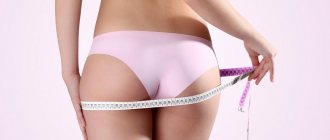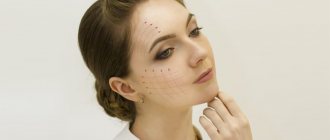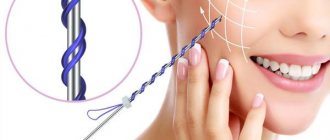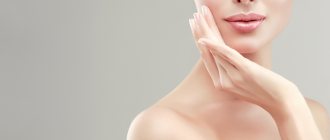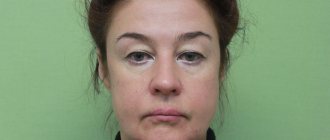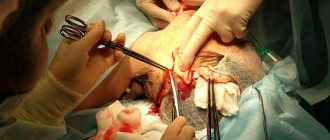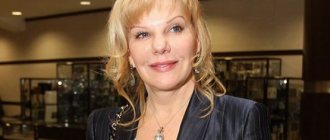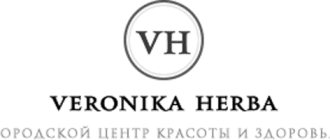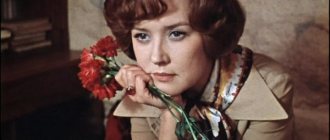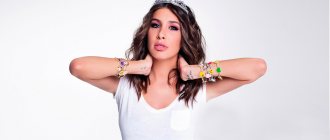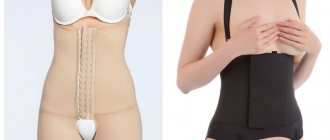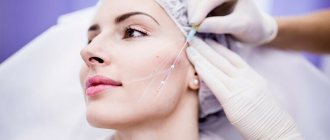Thread lifting is a safe alternative to traditional surgery. This technique is suitable for patients of any age and is well tolerated. In terms of effectiveness, thread lifting is not inferior to radical surgery, however, after such an intervention there are no noticeable scars, and the recovery period lasts no more than a week.
Let's find out what non-surgical lifting is.
Triangle or inverted triangle?
What is the most obvious sign of aging? Many will say “wrinkles,” but this is far from the only sign of age. If you carefully care for your skin and protect it from the sun, the first wrinkles may appear quite late. But a “floating” oval of the face, unclear features, folds, jowls and a double chin can be observed at an earlier age. These signs clearly indicate the age of their owner, even if the skin remains smooth.
In youth, the face resembles a triangle with the top down - the greatest volume is in the cheekbones, and the face narrows towards the chin.
Over the years, the face looks more and more like a triangle with the apex up - under the influence of gravity, the tissues gradually shift downwards, as a result, the middle third of the face loses volume, but the lower one becomes more massive. This type of aging (called deformation) is especially common in people who are prone to obesity.
Coping with the effects of gravity is much more difficult than smoothing out fine wrinkles and saturating the skin with moisture. Previously, the only solution was a circumferential lift - a serious operation requiring long-term rehabilitation. And then a worthy alternative to surgical intervention appeared - thread lifting.
Comparison with similar procedures
Manipulation of mesothreads is considered a universal method for eliminating age-related changes. Threadlifting is performed on patients of all ages. The cost of the operation allows the technique to be used by a wide range of people. These characteristics of thread lifting are similar to those inherent in the most often opposed technique - contouring with fillers.
The impact gives a natural result. Choosing suitable mesothreads is easier than choosing filler. Threadlifting is less likely to cause complications. Gel injections are often aimed at eliminating wrinkles, and the installation of threads successfully combats ptosis. There are more nuances when working with fillers that affect the quality of the result.
The essence of the technique
Thread lifting, mesothreads, bio-reinforcement, thread lifting - there are many names, but the essence is the same: special elastic threads are introduced under the skin, with the help of which the tissues are held where required to form a “triangle of youth” (top down).
The work of a cosmetologist is to create a kind of frame that supports the skin (a study confirming the safety of thread lifting using the example of Happy Lift threads).
The history of this technique began long before our era - scientists found mummies with traces of similar interventions on their faces. Ancient Egyptian cosmetologists used thin threads of gold to reinforce the face - the noble metal did not cause allergic reactions and was not rejected by the body.
At the end of the 20th century, scientists adapted the ancient technology and began to perform lifts with gold threads. Unfortunately, the technique did not fully live up to the hopes placed on it: the metal threads perfectly tightened the face, but appeared under the skin.
Nowadays gold threads are used very rarely for two reasons. Firstly, they can be noticeable by sight or touch. And secondly, implanted gold threads are a contraindication for any hardware cosmetic procedures.
The search began for other materials for thread lifting: gold and platinum were replaced by synthetics, and then by a self-absorbable polymer based on polylactic acid or polydioxanone. Now doctors mainly use such threads - they are safe, hypoallergenic and completely invisible. Surgical suture material is made from these materials.
Over time, the threads decompose into water and carbon dioxide - substances that are compatible with human tissues and the products of their decomposition are eliminated naturally. However, the lifting effect persists even after the threads are absorbed. The fact is that the presence of a foreign body under the skin stimulates the production of structural proteins. As a result, each thread is covered with a layer of natural collagen - in place of the artificial frame, a completely natural one is formed, which also copes well with the task of holding tissue.
This ensures a prolonged effect that can last for several years. And what is especially important is that the result looks absolutely natural, and there are no traces left after the intervention.
Description of the procedure
Installation of mesothreads is carried out under local anesthesia. Application anesthesia with ointment or the use of local anesthetic injections is sufficient. Before the operation, the skin of the intended impact sites is cleaned and disinfected with an antiseptic.
The doctor assesses the severity of the defects and makes markings for installing mesothreads. The cosmetologist makes punctures in the lower boundaries of the contour lines. The doctor inserts a blunt-ended cannula into the resulting hole. The tool becomes a guide for the finest mesothread.
The cannula is advanced under the skin strictly along the drawn contour. The instrument is removed, the mesothread remains inside the tissue. The material is pulled to the desired position. The free ends are cut off. The puncture sites are disinfected and treated with a regenerating agent.
The operation lasts 20–30 minutes. Side effects are rare. After receiving recommendations for further care from the cosmetologist, you can safely return to your usual activities.
Types of threads
First of all, all threads can be divided into absorbable and non-absorbable. In both cases, completely safe materials are used - polypropylene, polylactic acid, polydioxanone and others.
The threads differ not only in material, but also in shape.
They can be:
- Smooth (monofilament);
- Braided (“braids”);
- Spiral-shaped (“springs”);
- With spikes, cones, miniature claw hooks.
This variety of forms is explained by the fact that with the help of thread lifting you can solve a variety of problems. Thus, monofilaments are good for tightening the skin and fine work on the most delicate areas.
Wicker varieties can support a lot of weight due to their structure. They are well suited for strengthening the oval of the face and other areas where the load on the threads is quite high.
Thanks to their shape, the “springs” quickly restore their original shape. They are suitable for use on moving areas where lifting is required - for example, in the corners of the lips.
Threads with spikes, “claws” and cones are firmly fixed in the fabrics. This is an ideal option in cases where you need to correct ptosis and lift tissue. Such varieties are often used to lift not only the face, but also the body.
The success of the procedure largely depends on the correct choice of mesothreads. Often, cosmetologists combine different types to achieve the optimal effect, for example, monofilaments are used in the periorbital area, and jowls are removed using “braids” or “springs” or threads with notches.
Opinion of cosmetologists
Doctors rely on the effectiveness of a multifaceted approach. Combining different methods to solve a problem brings a decent result. When eliminating nasolabial folds, cosmetologists prefer to use threads and fillers simultaneously.
Cosmetologists prefer to combine methods of eliminating problems and offer combined options to patients.
The cosmetologist is sure that threads do a better job of eliminating ptosis in the nasolabial area.
The cosmetologist is sure that it is easier to remove ptosis with threads; other methods will enhance the effect.
Manufacturers
Products from different manufacturers are used for thread lifting. All types of mesothreads are intended for professional use only.
Here are just some of the well-proven options:
- Beauty' lift V Line Rose And Fix Rose. These South Korean varieties are supplemented with notches, which, like rose thorns, are fixed in the tissues and allow them to be fixed in the desired position. They are usually used to lift the middle and lower third of the face (jowls, cheeks, nasolabial folds). The set includes a cannula and a biodegradable thread based on polydioxanone;
- Beaute' lift V Line Mini Rose and Mini Double. This option is also suitable for correcting the area of the cheeks, eyebrows, and jowls . The notches provide strong fixation in the tissues. The introduction is carried out using a special guide needle;
- Mesothreads Cog They are also of Korean origin. Thanks to multidirectional notches, they are well fixed in the tissues for effective tightening.
Biodegradable material is absorbed after 1.5-2 months; By this time, a natural collagen framework is formed that holds the tissue. The effect lasts for an average of 2 years; - The selection of mesothreads from the Korean manufacturer Line Lift is unusually wide. There are options for different zones, with notches, in the form of springs, with the effect of botulinum toxin, for lifting and reinforcement;
- American mesothreads Silhouette Lift are made of non-absorbable polypropylene, complemented by retaining cones made of biodegradable material.
The tightening effect lasts for a record period - up to 6 years, and then you can tighten the threads again without implanting new ones; - Silhouette Soft based on polylactic acid, they dissolve without residue, simultaneously moisturizing the skin and improving its quality. The effect of the procedure increases over several months, reaching a maximum six months after implantation.
Benefits of thread lifting
- Thread lifting is the only injection procedure that can be considered a full-fledged alternative to surgical lifting;
- One session is enough to achieve impressive results;
- No special training required;
- The effect is noticeable immediately, it increases over several months and lasts for at least 2-3 years;
- This is a minimally invasive intervention: threads are inserted through tiny punctures that heal without a trace;
- The technique can be used to lift the face, body, and hands;
- Superficial anesthesia is sufficient to completely eliminate discomfort;
- Lifting with absorbable mesothreads can be combined with various cosmetic procedures;
- Implantation of mesothreads triggers the processes of skin rejuvenation in the treated areas: the production of hyaluronic acid, elastin and collagen production increases;
- The procedure is safe. The rehabilitation period lasts no more than two weeks, the risk of complications is several times less than with plastic surgery.
Patient reviews
To correct nasolabial folds, patients often use Botox and fillers. The threads have not yet become widespread. Many cosmetologists prefer to work with fillers. Patients who have undergone thread lifting are satisfied with the results. Reviews about thread lifting are in most cases positive.
The patient is satisfied with the effect of the threads in the area of the nasolabial folds, but is confident that adding filler will improve the picture.
The patient is satisfied with the technique and notices strengthening of the tissues.
Indications
It is believed that thread lifting is especially effective at the age of 30-50 years.
However, a competent cosmetologist does not focus on calendar age, but on the condition of the body, skin and subcutaneous structures. Some people may already develop a double chin in their youth - in this case, there is no point in waiting several years to undergo a procedure that will significantly improve their appearance and get rid of complexes for several years. At the same time, patients who have little subcutaneous fat and well-developed muscle tissue may only need such a lift after the age of fifty.
In some cases, lifting is recommended to be combined with other procedures, for example, with photorejuvenation or peelings to improve skin quality, or with contouring to correct facial features.
Main indications for bioreinforcement:
- Nasolabial folds;
- Bryli;
- Double chin;
- Drooping corners of lips, eyebrows, eyes;
- Gravitational ptosis;
- Full cheeks;
- Fuzzy, blurry facial features;
- Loose skin in the neck and décolleté, chest, abdomen or buttocks;
- Sagging skin on the face and/or body;
- Bags under the eyes;
- Eyebrow lifting.
Although thread lifting is most often used for rejuvenation, thread lifting can also transform young people. Wide eyes and slightly raised corners of the lips will make any appearance more pretty and attractive.
Contraindications
- Bleeding disorders;
- Oncological diseases;
- Autoimmune diseases;
- Dermatological diseases, rashes in the puncture area;
- Any acute illness or exacerbation of chronic illnesses;
- Pregnancy, lactation;
- Decompensated diabetes mellitus;
- Acute infectious diseases.
Girls are not recommended to carry out the procedure during menstruation. During this period, sensitivity increases and blood clotting decreases; in addition, the face may be swollen, so it is better to wait a few days.
Advantages and disadvantages
Thread lifting of nasolabial folds is praised by cosmetologists and patients for:
- naturalness of the result;
- hypoallergenic materials;
- easy tolerability of the procedure;
- low likelihood of serious complications;
- speed of surgery and recovery;
- prolonged preservation of the effect.
The disadvantages of thread lifting include:
- high requirements for the qualifications of a doctor;
- the likelihood of pain and long-term persistence of symptoms;
- demanding attitude to facial expressions in the recovery period.
Mesothreads dissolve on their own. Any discomfort goes away as this process progresses.
Rehabilitation
You should not prescribe important measures immediately after a visit to the doctor - unlike other injection procedures, after bioreinforcement the skin needs time to recover. As a rule, the rehabilitation period is 5-6 days, but sometimes it can reach up to two weeks. The exact timing depends on the treatment area, type of thread and individual characteristics. So, if threads with spikes and hooks are used that capture subcutaneous structures, it will take more time than for a light lifting of the ends of the eyebrows and smoothing out wrinkles.
In some cases, mild pain in the treated areas may occur after the procedure. The more pronounced the lifting effect, the more intense these sensations. It takes time for the puncture sites to heal completely and for the displaced tissues to “get used” to their new location.
So discomfort, swelling, skin irritation and redness for several days are completely normal.
If necessary, the doctor will recommend painkillers to eliminate discomfort during the rehabilitation period. In any case, the discomfort is not at all as intense as after surgery and disappears much faster.
Do not use decorative cosmetics or any creams during the day.
Only products recommended by a cosmetologist are suitable for caring for puncture sites. It is also not recommended to drink alcohol and touch the treated areas again. Intense sports activities and any thermal procedures are prohibited.
During the week, you will have to limit any actions that create unnecessary tension in the treated area. For example, after a lip and cheek lift, you should talk less, not smile too widely, and avoid foods that require prolonged chewing. If the threads are implanted in the forehead area, then you should not frown or frown. And if the chest area has been treated, then a strict ban applies to any exercises that strain the pectoral muscles.
For two weeks, massage and any cosmetic effects on the treated area are prohibited.
It is highly advisable to eliminate, or at least greatly limit, alcohol consumption. Before going outside, you should use a cream with ultraviolet protection.
Consequences
Undesirable consequences are a rare occurrence if the material installation technology is followed and the doctor’s instructions are followed. To eliminate side effects during thread lifting, you need to take a balanced approach to choosing a cosmetologist and adhere to the requirements and recommendations of the doctor. Various violations can lead to:
- asymmetry;
- formation of skin irregularities;
- translucent material;
- aggravation of the age-related picture (tightening of the skin);
- damage to blood vessels and nerves (numbness, cyanosis);
- dysfunction (chewing food, facial expressions).
Negative consequences after the installation of mesothreads are possible due to low competence of the doctor, non-compliance with the conditions of rehabilitation by the patient, and the individual response of the body. Carrying out thread lifting in unsanitary conditions is fraught with infection, inflammation, and subsequent scarring on the skin.
The natural reaction of the body to the introduction of foreign material is considered to be swelling, local hemorrhage, and quickly passing redness. Pain may occur in the places where mesothreads are installed. Manifestations may linger for 2–5 days. Excessive spread and long-term persistence of symptoms require additional involvement of a doctor.
Side effects
- The most common complications arise from damage to blood vessels and nerves during tissue puncture. The use of pointed needles is unsafe when inserted deep into the dermis. The risk of bleeding, hematoma development and edema will be minimal when using a blunt cannula. Numbness due to injury to nerve trunks is rarely diagnosed.
- Sometimes an exacerbation of herpes and infection at the injection site is possible. Such consequences are the result of non-compliance with the rules of asepsis and antisepsis, as well as unsatisfactory postoperative care.
- Improper superficial introduction of the material can result in the threads contouring (seeing through) through the skin or causing retraction of the skin. Unpleasant effects disappear on their own after 10-15 days. The fiber discolors even faster, in about a week. Smooth linear varieties can migrate and change location within tissues.
- Quite often the end comes out. The situation arises if the angle of insertion is less than 45 degrees. The exit site is treated with an antiseptic, the fiber is cut with a sterile instrument and tucked under the skin.
- Rarely does the tip fall under the epidermis, which can lead to the appearance of a papule. When opening the element, a piece of thread is found in its bottom, which needs to be cut and removed under the skin.
Buyanov Sergey Yurievich (Expert Doctor):
It is strictly forbidden to pull the thread at home using improvised means. The mesothread is overgrown with connective tissue, so any forceful pulling can lead to subcutaneous hemorrhage.
Cost of reinforcement of nasolabial folds with mesothreads
The cost of the threadlifting procedure directly depends on the number of threads that the specialist uses to insert under the skin. To treat the nasolabial area, up to 20 mesothreads may be needed, which are introduced according to the scheme, providing skin tightening and smoothing of even the deepest folds.
At the Etisel health and beauty center, you will be offered the best prices for the procedure of reinforcing nasolabial folds with mesothreads. You can also take advantage of one of our promotions and get the opportunity to save money while restoring a youthful, smooth and radiant appearance to your skin.
